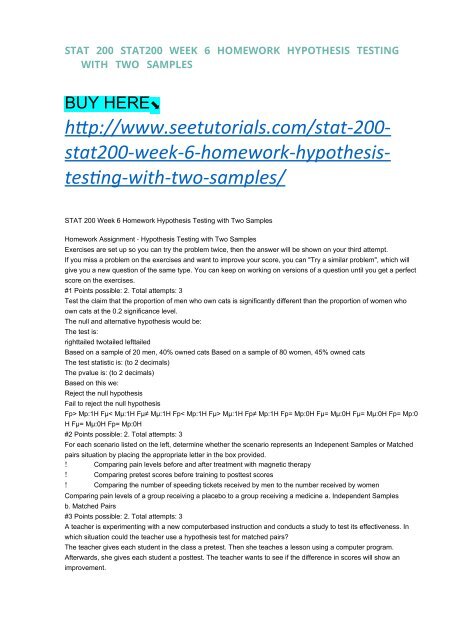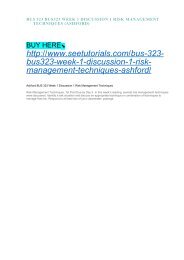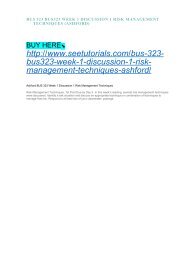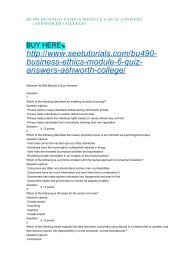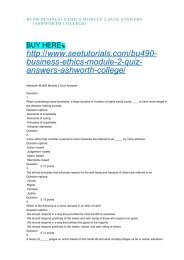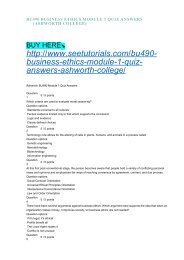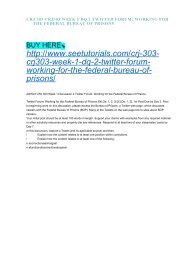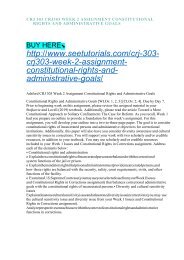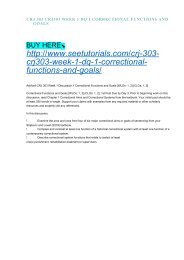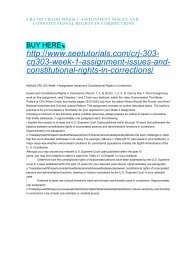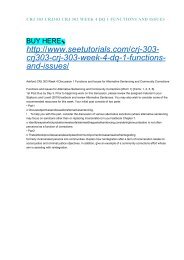STAT 200 STAT200 WEEK 6 HOMEWORK HYPOTHESIS TESTING WITH TWO SAMPLES
Create successful ePaper yourself
Turn your PDF publications into a flip-book with our unique Google optimized e-Paper software.
<strong>STAT</strong> <strong>200</strong> <strong>STAT</strong><strong>200</strong> <strong>WEEK</strong> 6 <strong>HOMEWORK</strong> <strong>HYPOTHESIS</strong> <strong>TESTING</strong><br />
<strong>WITH</strong> <strong>TWO</strong> <strong>SAMPLES</strong><br />
BUY HERE⬊<br />
htp://www.seetutorials.com/stat-<strong>200</strong>-<br />
stat<strong>200</strong>-week-6-homework-hypothesistestng-with-two-samples/<br />
<strong>STAT</strong> <strong>200</strong> Week 6 Homework Hypothesis Testing with Two Samples<br />
Homework Assignment ‐ Hypothesis Testing with Two Samples<br />
Exercises are set up so you can try the problem twice, then the answer will be shown on your third attempt.<br />
If you miss a problem on the exercises and want to improve your score, you can "Try a similar problem", which will<br />
give you a new question of the same type. You can keep on working on versions of a question until you get a perfect<br />
score on the exercises.<br />
#1 Points possible: 2. Total attempts: 3<br />
Test the claim that the proportion of men who own cats is significantly different than the proportion of women who<br />
own cats at the 0.2 significance level.<br />
The null and alternative hypothesis would be:<br />
The test is:<br />
righttailed twotailed lefttailed<br />
Based on a sample of 20 men, 40% owned cats Based on a sample of 80 women, 45% owned cats<br />
The test statistic is: (to 2 decimals)<br />
The pvalue is: (to 2 decimals)<br />
Based on this we:<br />
Reject the null hypothesis<br />
Fail to reject the null hypothesis<br />
Fp> Mp:1H Fμ< Mμ:1H Fμ≠ Mμ:1H Fp< Mp:1H Fμ> Mμ:1H Fp≠ Mp:1H Fp= Mp:0H Fμ= Mμ:0H Fμ= Mμ:0H Fp= Mp:0<br />
H Fμ= Mμ:0H Fp= Mp:0H<br />
#2 Points possible: 2. Total attempts: 3<br />
For each scenario listed on the left, determine whether the scenario represents an Indepenent Samples or Matched<br />
pairs situation by placing the appropriate letter in the box provided.<br />
Comparing pain levels before and after treatment with magnetic therapy<br />
Comparing pretest scores before training to posttest scores<br />
Comparing the number of speeding tickets received by men to the number received by women<br />
Comparing pain levels of a group receiving a placebo to a group receiving a medicine a. Independent Samples<br />
b. Matched Pairs<br />
#3 Points possible: 2. Total attempts: 3<br />
A teacher is experimenting with a new computerbased instruction and conducts a study to test its effectiveness. In<br />
which situation could the teacher use a hypothesis test for matched pairs?<br />
The teacher gives each student in the class a pretest. Then she teaches a lesson using a computer program.<br />
Afterwards, she gives each student a posttest. The teacher wants to see if the difference in scores will show an<br />
improvement.
The teacher randomly divides the class into two groups. One of the groups receives computerbased instruction. The<br />
other group receives traditional instruction without computers. After instruction, each student takes a test and the<br />
teacher wants to compare the performance of the two groups.<br />
The teacher uses a combination of traditional methods and computerbased instruction. She asks students which they<br />
liked better. She wants to determine if the majority prefer the computerbased instruction.<br />
#4 Points possible: 2. Total attempts: 3<br />
5.32 Fuel efficiency of manual and automatic cars, Part I: Each year the US Environmental Protection Agency (EPA)<br />
releases fuel economy data on cars manufactured in that year. Below are summary statistics on fuel efficiency (in<br />
miles/gallon) from random samples of cars with manual and automatic transmissions manufactured in 2012. Do these<br />
data provide strong evidence of a difference between the average fuel efficiency of cars with manual and automatic<br />
transmissions in terms of their average city mileage? Assume that conditions for inference are satisfied.<br />
The hypotheses for this test are:<br />
Ho: μautomatic = μmanual Ha: μautomatic < μmanual<br />
Ho: μautomatic = μmanual Ha: μautomatic > μmanual<br />
Ho: μautomatic = μmanual Ha: μautomatic ≠ μmanual<br />
City MPG, Automatic City MPG, Manual<br />
Mean 16.12 19.85<br />
SD 3.58 4.51<br />
n 26 26<br />
The test statistic is:<br />
The pvalue is:<br />
Interpret the result of the hypothesis test in the context of the problem:<br />
(please round to two decimal places) (please round to four decimal places)<br />
The data provide sufficient evidence that there is a difference between the average fuel efficiency of manual and<br />
automatic cars in terms of their average city mileage<br />
The data do not provide sufficient evidence that there is a difference between the average fuel efficiency of manual<br />
and automatic cars in terms of their average city mileage<br />
The data provide sufficient evidence that there is no difference between the average fuel efficiency of manual and<br />
automatic cars in terms of their average city mileage<br />
#5 Points possible: 2. Total attempts: 3<br />
You wish to test the following claim ( ) at a significance level of . For the context of this problem, where the first data<br />
set represents a pretest and the second data set represents a posttest. (Each row represents the pre and post test<br />
scores for an individual. Be careful when you enter your data and specify what your and are so that the differences<br />
are computed correctly.)<br />
You believe the population of difference scores is normally distributed, but you do not know the standard deviation.<br />
You obtain the following sample of data:<br />
pretest posttest<br />
71.3 67.1<br />
92.6 97.1<br />
76.4 80.5<br />
57.5 58.3<br />
81.8 70.6<br />
27.4 19.2<br />
31.2 31.8<br />
40.3 27.4<br />
65.4 57.7<br />
59.6 52.1<br />
58.2 48.8<br />
56.8 35.1<br />
63.2 68.1<br />
76.4 67.7<br />
65.4 75.3<br />
80.7 74.7
54.6 51.7<br />
53.8 45.4<br />
48.2 35.6<br />
35.5 41.3<br />
What is the test statistic for this sample?<br />
test statistic = (Report answer accurate to 4 decimal places.)<br />
What is the pvalue for this sample?<br />
pvalue = (Report answer accurate to 4 decimal places.)<br />
The pvalue is...<br />
less than (or equal to) greater than<br />
This test statistic leads to a decision to...<br />
<strong>200</strong>.0 = α<br />
tseTerP − tseTtsoP = dμ aH<br />
2μ<br />
1μ<br />
α α<br />
0 ≠ dμ:aH 0 = dμ:oH<br />
reject the null accept the null<br />
fail to reject the null<br />
As such, the final conclusion is that...<br />
There is sufficient evidence to warrant rejection of the claim that the mean difference of posttest from pretest is not<br />
equal to 0.<br />
There is not sufficient evidence to warrant rejection of the claim that the mean difference of posttest from pretest is<br />
not equal to 0.<br />
The sample data support the claim that the mean difference of posttest from pretest is not equal to 0.<br />
There is not sufficient sample evidence to support the claim that the mean difference of posttest from pretest is not<br />
equal to 0.


